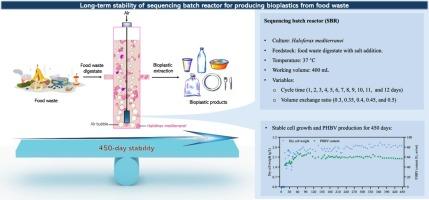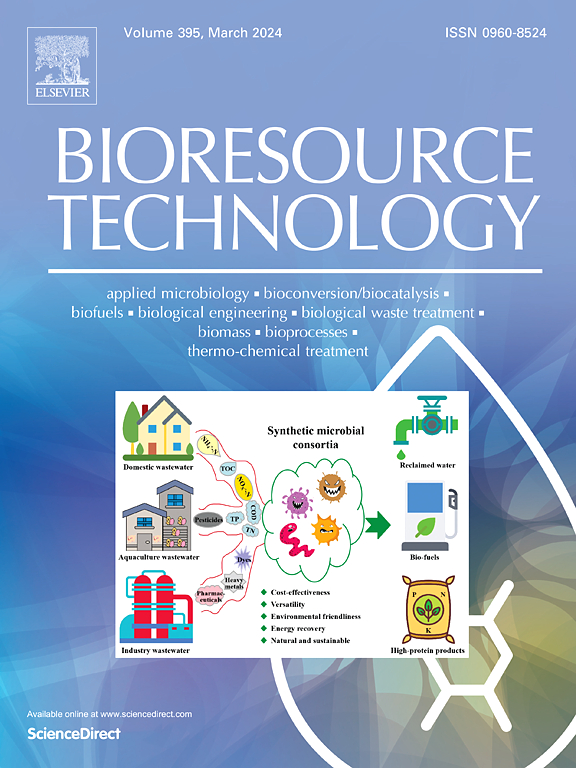循环时间和体积交换比对在序批式反应器中培养 Haloferax mediterranei 450 天后从厨余消化物中生产聚(3-羟基丁酸-3-羟基戊酸)的长期影响。
IF 9.7
1区 环境科学与生态学
Q1 AGRICULTURAL ENGINEERING
引用次数: 0
摘要
将食物废渣注入一个用于生产聚(3-羟基丁酸-co-3-羟基戊酸)(PHBV)的Haloferax mediterranei(HM)定序批式反应器(SBR)中。该 SBR 不间断运行了 450 天,以测试其稳定性,期间改变了循环时间和容积交换率,以了解它们在不同有机负荷率(OLR)下对 PHBV 发酵性能的影响。结果表明:1)PHBV 产率与食物废渣的 OLR 成正比;2)底物和产物抑制是制约底物利用率和 PHBV 产率的两个限制因素;3)PHBV 滴度取决于 SBR 的水力停留时间,而体积交换比低于 0.5 则不利于产物抑制剂的积累。该研究首次证明了以食物垃圾为原料通过 HM 生产 PHBV 的长期稳定性,并揭示了抑制效应可能成为 SBR 中的障碍,从而限制了该技术的全面应用。本文章由计算机程序翻译,如有差异,请以英文原文为准。

Long-term effects of cycle time and volume exchange ratio on poly(3-hydroxybutyrate-co-3-hydroxyvalerate) production from food waste digestate by Haloferax mediterranei cultivated in sequencing batch reactors for 450 days
Food waste digestate was fed into a sequencing batch reactor (SBR) for Haloferax mediterranei (HM) to produce poly(3-hydroxybutyrate-co-3-hydroxyvalerate) (PHBV). This SBR was operated uninterruptedly for 450 days to test its stability, during which the cycle time and volume exchange ratio were varied to understand their impacts on the PHBV fermentation performance under ranged organic loading rates (OLR). Results showed that 1) PHBV productivity was proportional to OLR of food waste digestate; 2) substrate and product inhibitions were two limiting factors constraining substrate utilization and PHBV yields; 3) PHBV titer was dependent on the hydraulic retention time of the SBR while a volume exchange ratio lower than 0.5 is unfavorable due to the product inhibitor accumulation. This study for the first time demonstrated that the long-term stability of food waste-fed PHBV production by HM and revealed that inhibition effects could be barriers in SBR limiting the full-scale application of the technology.
求助全文
通过发布文献求助,成功后即可免费获取论文全文。
去求助
来源期刊

Bioresource Technology
工程技术-能源与燃料
CiteScore
20.80
自引率
19.30%
发文量
2013
审稿时长
12 days
期刊介绍:
Bioresource Technology publishes original articles, review articles, case studies, and short communications covering the fundamentals, applications, and management of bioresource technology. The journal seeks to advance and disseminate knowledge across various areas related to biomass, biological waste treatment, bioenergy, biotransformations, bioresource systems analysis, and associated conversion or production technologies.
Topics include:
• Biofuels: liquid and gaseous biofuels production, modeling and economics
• Bioprocesses and bioproducts: biocatalysis and fermentations
• Biomass and feedstocks utilization: bioconversion of agro-industrial residues
• Environmental protection: biological waste treatment
• Thermochemical conversion of biomass: combustion, pyrolysis, gasification, catalysis.
 求助内容:
求助内容: 应助结果提醒方式:
应助结果提醒方式:


